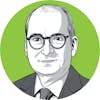 See
more of the story
See
more of the story
Starting a bank isn't easy. Starting one when interest rates are rising is even harder.
But that's what five local veteran bankers did by forming EntreBank a year ago this month. It's the first new-from-scratch bank in the state since the 2008 financial crisis.
As banking faces new scrutiny following the collapse of Silicon Valley Bank (SVB) and a handful of other larger business-oriented banks, EntreBank is doing fine, two of its executives said. It surpassed growth goals for its first year and, amid this month's turmoil, saw deposits rise 20%.
"People are moving to us in large part because they see we don't have the legacy investment portfolio issues," said Erik Knutson, chief financial officer.
"It's a mixture of that and a number of clients we've been talking to for a period of time and were already moving their relationship over before this happened," Tim Viere, chief executive officer, added.
Banks such as SVB and Signature invested much of their depositors' money in long-term bonds. That's usually a smart strategy, but it turned into a value loser as interest rates rose over the past year.
It also created a liquidity problem. Both banks were vulnerable to bank runs because a high percentage of their depositors held balances exceeding $250,000, the maximum insured by the Federal Deposit Insurance Corp.
Being new and focused on business customers, EntreBank also has a high proportion of its depositor base with more than $250,000 in it. But unlike those troubled banks, EntreBank can readily access its depositors' money because it's in the shortest-term, most liquid investment possible available to banks: the overnight account of the Federal Reserve.
"Our mentality has been to stay very liquid because we're planning to have continued growth," Viere said. "We really don't want to play market risk with our investment portfolio because of the growth we're having."
The bank started with about $30 million in assets. It now has between $125 million and $130 million, the executives said.
As it turned out, relying on liquidity was also surprisingly lucrative. Last year, the yield curve inverted in bonds and short-term maturities unusually provided better rates than long-term ones.
"It's a strange bond market yield curve, but it's working to our advantage," Knutson said. "Until that changes, this is right for us on a couple of fronts, to fund the growth and we're getting more for it in income."
The bankers said they're also confident that their customers are not the kinds of businesses that burn through cash. While EntreBank is new, its bankers brought in businesses they have been working with for years, sometimes more than two decades.
"Our depositor base is very stable," Viere said. "That doesn't mean that somebody's not going to need deposits if they're going to buy a building or equipment or they have other expenses. That's the normal course of business."
EntreBank is the brainchild of Dan Boeckermann, who started Venture Bank in 2001. After that bank was sold to Fargo-based Choice Financial in 2018, Boeckermann sought to create a new one that forged the close customer relationships that a community bank does but with the broad services of a commercial bank.
He attracted Viere from Merchants Bank and Knutson from Drake Bank. Todd Hovland, the new bank's president, came from MidWestOne Bank. And Melissa Johnston, the chief credit and marketing officer, came from Highland Bank. The five had never worked together, but they brought client relationships from across the metro area to EntreBank.
"Todd has done a lot of work in tax credit finance. Melissa has a strong background in business acquisition lending," Viere said.
The core group hired nine others to launch EntreBank, including a credit team with a record of helping businesses navigate financing with the U.S. Small Business Administration. The staff now has 17 people who, after months in a temporary space, work in a newly designed office in Bloomington near the airport and the Mall of America.
While EntreBank's business model and capital structure are sound, its bankers and customers still grapple with the same uncertainties everyone else does — about inflation and the future cost of money.
"The raising of interest rates is causing what the Federal Reserve wanted," Viere said. "The question is what will inflation look like over the next few months. None of us know. So when we're looking at things now, we all have to prepare as if rates are going to go up and down all at the same time."



